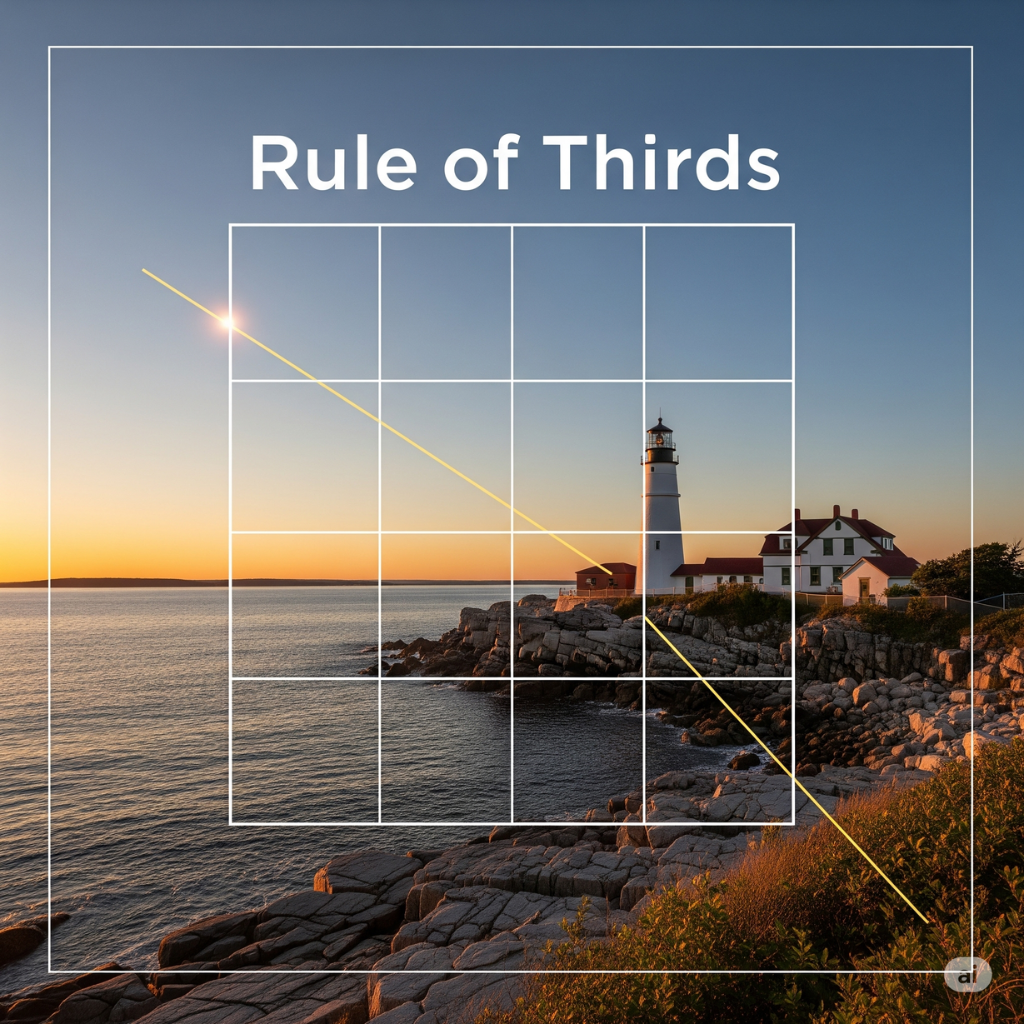
Photography is an art that beautifully blends creativity with technical skill. One fundamental concept every budding photographer should grasp is the rule of thirds. This simple yet powerful guideline can significantly enhance your photographic compositions, making your images more engaging and aesthetically pleasing. In this post, I will explain what the rule of thirds is, how it works, how it can improve your photos, and some practical tips on implementing it in your photography.
What is the Rule of Thirds?
The rule of thirds is a basic principle of composition in visual arts, including photography, painting, and design. It involves dividing an image into nine equal parts by two equally spaced horizontal lines and two equally spaced vertical lines. By placing key elements of your composition along these lines or at their intersections, you create more balance, interest, and dynamism in your photos.
Imagine your camera’s viewfinder or LCD screen with a grid overlay – this grid is the rule of thirds. The idea is to avoid centering your main subject but instead, position it along the lines or at the points where the lines intersect. This technique helps to draw the viewer’s eye naturally across the image, making the composition more engaging and dynamic.
How Does the Rule of Thirds Work?
To understand how the rule of thirds works, let’s break it down into a few key points:
- Grid Layout: Picture your frame divided into nine sections. These sections are formed by two horizontal and two vertical lines that split the image into thirds both horizontally and vertically.
- Placement of Elements: Place important elements of your photo along these lines or at their intersections. This positioning helps create a more balanced and interesting composition.
- Natural Eye Movement: The human eye naturally gravitates towards these intersections and lines. By aligning your subject with the rule of thirds, you guide the viewer’s gaze in a more natural and pleasing way.
Why Use the Rule of Thirds?
The rule of thirds can dramatically improve your photography for several reasons:
- Balanced Composition: Centering a subject can sometimes lead to a static and less engaging photo. The rule of thirds introduces a sense of balance and harmony by offsetting the main subject.
- Dynamic and Engaging Images: Photos that follow the rule of thirds tend to be more dynamic and interesting. They encourage the viewer’s eye to explore the entire frame rather than focusing solely on the center.
- Professional Look: Applying this rule can make your photos look more polished and professional. It’s a technique used by many seasoned photographers and artists to create compelling compositions.
Tips for Using the Rule of Thirds
Now that you understand the rule of thirds and its benefits, let’s explore some practical tips on how you can apply it in your photography:
- Enable the Grid: Most digital cameras and smartphones have an option to display a grid overlay on the screen. Turn this feature on to help you visualize the rule of thirds while composing your shots.
- Practice with Static Subjects: Start practicing the rule of thirds with subjects that don’t move, like landscapes, buildings, or still life. This will give you time to compose your shot carefully.
- Focus on Eyes in Portraits: When shooting portraits, place the subject’s eyes along the top horizontal line. This not only adheres to the rule of thirds but also ensures the eyes, which are typically the focal point, draw attention.
- Align Horizons: For landscape photography, place the horizon along either the top or bottom horizontal line. This creates a balanced composition and adds depth to your photo.
- Off-Center Main Subjects: Position your main subject at one of the four intersection points of the grid. This will make your photo more interesting and guide the viewer’s eye naturally.
- Experiment and Break the Rule: While the rule of thirds is a great guideline, don’t be afraid to break it if it serves your creative vision. Some of the most iconic photos break conventional rules to convey a unique perspective.
- Crop for Composition: If your shot doesn’t quite adhere to the rule of thirds, don’t worry. You can always crop your photo during post-processing to improve the composition. Tools like Adobe Lightroom or Photoshop make this process straightforward.
- Study Great Photographs: Look at the work of accomplished photographers and analyze how they use the rule of thirds. Understanding their techniques can inspire and improve your own compositions.
- Combine with Other Techniques: The rule of thirds can be combined with other compositional techniques like leading lines, symmetry, and framing to create even more compelling images.
Practical Examples of the Rule of Thirds
Let’s look at some practical examples to illustrate how the rule of thirds can transform an image:
- Landscapes: Imagine a photo of a sunset over the ocean. By placing the horizon along the lower third and the sun at one of the intersections, you create a balanced and engaging composition that draws the viewer’s eye across the entire image.
- Portraits: In a portrait of a person standing against a scenic background, placing the person’s eyes along the top third and slightly off-center can make the photo more dynamic and highlight the person’s expression.
- Architecture: For a photo of a building, aligning the main vertical lines of the structure with the vertical lines of the grid can emphasize the building’s shape and create a pleasing symmetry.
- Action Shots: In sports or wildlife photography, positioning the subject along one of the vertical lines and leaving space in the direction they are moving or looking towards can convey emotion and anticipation.
Common Mistakes and How to Avoid Them
While the rule of thirds is straightforward, beginners might make a few common mistakes. Here are some pitfalls to watch out for and how to avoid them:
- Overusing the Rule: Rigidly applying the rule of thirds to every shot can lead to predictable and monotonous photos. Use it as a guideline, but also trust your creative instincts.
- Ignoring the Subject: Sometimes, photographers focus too much on aligning with the grid and forget about the subject itself. Ensure that the subject remains the focal point, and use the rule to enhance, not dictate the composition.
- Poor Grid Visualization: If you struggle to visualize the grid, take advantage of your camera’s grid overlay feature. Practice makes perfect, and soon you’ll be able to mentally apply the rule without the overlay.
- Neglecting Other Elements: Composition is about more than just the rule of thirds. Don’t forget other essential elements like lighting, depth of field, and color balance.
Final Thoughts
The rule of thirds is an invaluable tool in the arsenal of any photographer, particularly beginners. By understanding and applying this simple guideline, you can create more balanced, dynamic, and visually appealing photos. Remember, the rule of thirds is not a strict rule but a helpful guideline. Use it to enhance your compositions, but don’t be afraid to experiment and find your unique style.
Happy shooting!
Did you enjoy this post? Do you want to know when the next post comes out? Consider subscribing. I only send update emails once a week, usually on Friday. Try it out. You can unsubscribe at any time.
